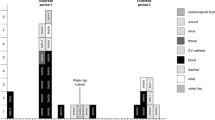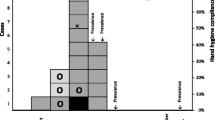Abstract
Purpose
In 2013, the German Commission for Hospital Hygiene and Infectious Disease Prevention (KRINKO) stated that extending weekly colonisation screening from very low birth weight (VLBW) infants (<1500 g) to all patients in the Neonatal Intensive Care Unit (NICU) might be useful.
Methods
After implementing this recommendation, we detected a previously unnoticed cluster of Serratia marcescens. Strains were typed by Pulsed Field Gel Electrophoresis (PFGE).
Results
Over 6 months, 19 out of 159 infants acquired S. marcescens. Twelve of the nineteen patients with S. marcescens were non-VLBW infants, and they were colonised significantly earlier than were VLBW infants (median 17 vs. 28 days; p < 0.01). Molecular typing revealed a polyclonal outbreak with multiple strain types leading to one or two transmissions each and a dominating outbreak strains being involved in an explosive outbreak involving eight neonates.
Conclusion
The revised KRINKO recommendation may help identify unnoticed outbreaks. Colonised non-VLBW patients may be an underestimated source of S. marcescens.


Similar content being viewed by others
References
Institute CoHHaIPotRK. Recommendation for the prevention of nosocomial infections in neonatal intensive care patients with a birth weight less than 1,500 g. Report by the Committee of Hospital Hygiene and Infection Prevention of the Robert Koch Institute. Bundesgesundheitsblatt Gesundheitsforschung Gesundheitsschutz. 2007;50(10):1265–303.
Institute CoHHaIPotRK. Hygiene measures for infection or colonization with multidrug-resistant gram-negative bacilli. Commission recommendation for hospital hygiene and infection prevention (KRINKO) at the Robert Koch Institute (RKI). Bundesgesundheitsblatt Gesundheitsforschung Gesundheitsschutz. 2012;55(10):1311–54. doi:10.1007/s00103-012-1549-5.
Institute CoHHaIPotRK. Commission recommendation for hospital hygiene and infection prevention (KRINKO) at the Robert Koch Institute (RKI). Ergänzende Empfehlung: Praktische Umsetzung sowie krankenhaushygienische und infektionspräventive Konsequenzen des mikrobiellen Kolonisationsscreenings bei intensivmedizinisch behandelten Früh- und Neugeborenen. Epidemiol Bull. 2013;2013(42):421–33.
Maragakis LL, Winkler A, Tucker MG, Cosgrove SE, Ross T, Lawson E, et al. Outbreak of multidrug-resistant Serratia marcescens infection in a neonatal intensive care unit. Infect Control Hosp Epidemiol. 2008;29(5):418–23. doi:10.1086/587969.
Maseda H, Hashida Y, Shirai A, Omasa T, Nakae T. Mutation in the sdeS gene promotes expression of the sdeAB efflux pump genes and multidrug resistance in Serratia marcescens. Antimicrob Agents Chemother. 2011;55(6):2922–6. doi:10.1128/AAC.01755-10.
Haertel C, Simon A, Geffers C, Schaper A, Herting E, Goepel W. Nosocomial infections in very low birth weight infants. Implementation of KRINKO recommendations in centers participating in the German Neonatal Network. Monatsschr Kinderheilkd. 2013;161:27–33. doi:10.1007/s00112-012-2845-8.
Polilli E, Parruti G, Fazii P, D’Antonio D, Palmieri D, D’Incecco C, et al. Rapidly controlled outbreak of Serratia marcescens infection/colonisations in a neonatal intensive care unit, Pescara General Hospital, Pescara, Italy, April 2011. Eur Surv Bull Eur Mal Transm (Eur Commun Dis Bull) 2011;16(24). pii:19892.
Graham PL 3rd, Begg MD, Larson E, Della-Latta P, Allen A, Saiman L. Risk factors for late onset gram-negative sepsis in low birth weight infants hospitalized in the neonatal intensive care unit. Pediatr Infect Dis J. 2006;25(2):113–7. doi:10.1097/01.inf.0000199310.52875.10.
Anderson B, Nicholas S, Sprague B, Campos J, Short B, Singh N. Molecular and descriptive epidemiology of multidrug-resistant Enterobacteriaceae in hospitalized infants. Infect Control Hosp Epidemiol. 2008;29(3):250–5. doi:10.1086/527513.
Larson EL, Cimiotti JP, Haas J, Nesin M, Allen A, Della-Latta P, et al. Gram-negative bacilli associated with catheter-associated and non-catheter-associated bloodstream infections and hand carriage by healthcare workers in neonatal intensive care units. Pediatr Crit Care Med. 2005;6(4):457–61. doi:10.1097/01.PCC.0000163669.37340.91.
Grobner S, Linke D, Schutz W, Fladerer C, Madlung J, Autenrieth IB, et al. Emergence of carbapenem-non-susceptible extended-spectrum beta-lactamase-producing Klebsiella pneumoniae isolates at the university hospital of Tubingen, Germany. J Med Microbiol. 2009;58(Pt 7):912–22. doi:10.1099/jmm.0.005850-0.
Tenover FC, Arbeit RD, Goering RV, Mickelsen PA, Murray BE, Persing DH, et al. Interpreting chromosomal DNA restriction patterns produced by pulsed-field gel electrophoresis: criteria for bacterial strain typing. J Clin Microbiol. 1995;33(9):2233–9.
Stone SP, Cooper BS, Kibbler CC, Cookson BD, Roberts JA, Medley GF, Duckworth G, Lai R, Ebrahim S, Brown EM, Wiffen PJ, Davey PG. The ORION statement: guidelines for transparent reporting of outbreak reports and intervention studies of nosocomial infection. J Antimicrob Chemother. 2007;59:833–40
Samuelsson A, Isaksson B, Hanberger H, Olhager E. Late-onset neonatal sepsis, risk factors and interventions: an analysis of recurrent outbreaks of Serratia marcescens, 2006–2011. J Hosp Infect. 2014;86(1):57–63. doi:10.1016/j.jhin.2013.09.017.
Voelz A, Muller A, Gillen J, Le C, Dresbach T, Engelhart S, et al. Outbreaks of Serratia marcescens in neonatal and pediatric intensive care units: clinical aspects, risk factors and management. Int J Hyg Environ Health. 2010;213(2):79–87. doi:10.1016/j.ijheh.2009.09.003.
Eichenwald EC, Stark AR. Management and outcomes of very low birth weight. N Engl J Med. 2008;358(16):1700–11. doi:10.1056/NEJMra0707601.
Giles M, Harwood HM, Gosling DA, Hennessy D, Pearce CT, Daley AJ. What is the best screening method to detect Serratia marcescens colonization during an outbreak in a neonatal intensive care nursery? J Hosp Infect. 2006;62(3):349–52. doi:10.1016/j.jhin.2005.09.015.
Brady MT. Health care-associated infections in the neonatal intensive care unit. Am J Infect Control. 2005;33(5):268–75. doi:10.1016/j.ajic.2004.11.006.
Montagnani C, Cocchi P, Lega L, Campana S, Biermann KP, Braggion C, et al. Serratia marcescens outbreak in a neonatal intensive care unit: crucial role of implementing hand hygiene among external consultants. BMC Infect Dis. 2015;15:11. doi:10.1186/s12879-014-0734-6.
Maltezou HC, Tryfinopoulou K, Katerelos P, Ftika L, Pappa O, Tseroni M, et al. Consecutive Serratia marcescens multiclone outbreaks in a neonatal intensive care unit. Am J Infect Control. 2012;40(7):637–42. doi:10.1016/j.ajic.2011.08.019.
Madani TA, Alsaedi S, James L, Eldeek BS, Jiman-Fatani AA, Alawi MM, et al. Serratia marcescens-contaminated baby shampoo causing an outbreak among newborns at King Abdulaziz University Hospital, Jeddah, Saudi Arabia. J Hosp Infect. 2011;78(1):16–9. doi:10.1016/j.jhin.2010.12.017.
Macdonald TM, Langley JM, Mailman T, Allain K, Nelson G, Hatton L, et al. Serratia marcescens outbreak in a neonatal intensive care unit related to the exit port of an oscillator. Pediatr Crit Care Med. 2011;12(6):e282–6. doi:10.1097/PCC.0b013e31820ac42a.
Cullen MM, Trail A, Robinson M, Keaney M, Chadwick PR. Serratia marcescens outbreak in a neonatal intensive care unit prompting review of decontamination of laryngoscopes. J Hosp Infect. 2005;59(1):68–70. doi:10.1016/j.jhin.2004.08.003.
Landers T, Abusalem S, Coty MB, Bingham J. Patient-centered hand hygiene: the next step in infection prevention. Am J Infect Control. 2012;40(4 Suppl 1):S11–7. doi:10.1016/j.ajic.2012.02.006.
Kucken D, Feucht H, Kaulfers P. Association of qacE and qacEDelta1 with multiple resistance to antibiotics and antiseptics in clinical isolates of Gram-negative bacteria. FEMS Microbiol Lett. 2000;183(1):95–8.
Acknowledgments
MWP and SH were supported by the German Ministry of Education and Research (BMBF), Grant number 01KI1501. We thank Sybille Müller-Bertling and Kirstin Ganske for their excellent technical assistance.
Author information
Authors and Affiliations
Corresponding author
Ethics declarations
Financial support
No financial support was provided relevant to this article.
Conflict of interest
All authors report no conflicts of interest relevant to this article.
Rights and permissions
About this article
Cite this article
Dawczynski, K., Proquitté, H., Roedel, J. et al. Intensified colonisation screening according to the recommendations of the German Commission for Hospital Hygiene and Infectious Diseases Prevention (KRINKO): identification and containment of a Serratia marcescens outbreak in the neonatal intensive care unit, Jena, Germany, 2013–2014. Infection 44, 739–746 (2016). https://doi.org/10.1007/s15010-016-0922-y
Received:
Accepted:
Published:
Issue Date:
DOI: https://doi.org/10.1007/s15010-016-0922-y




